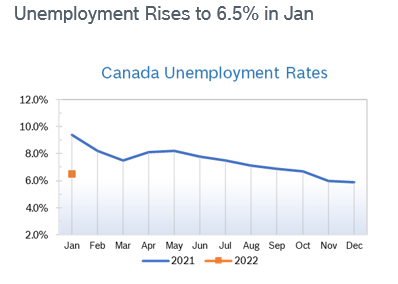The Consumer Price Index (CPI) rose 5.1% year over year in January after rising 4.8% in December. It was the first time the CPI has been over 5% since 1991, according to Statistics Canada. It was the tenth consecutive month that inflation has exceeded the Bank of Canada’s (BoC) target range of 1% to 3%. Supply chain disruptions, extreme weather events and labour shortages all contributed to the increase. It was the first time that more than 68% of the items in the “basket” used to calculate prices rose by more than 3%. Shelter costs jumped 6.2%year over year. Gasoline remains the biggest single contributor to rising prices. The BoC is widely expected to raise interest rates at the beginning of March. Housing and Construction News Canadian housing starts fell 3% in January compared with December as a decline in multiple urban outweighed a gain in single-detached urban starts, according to Canada Mortgage and Housing Corporation (CMHC). The seasonally adjusted annualized rate of housing starts dropped to 230,754 units in January, below analyst expectations of 245,000 and down from a revised 238,405 units in December. Home sales in January fell 10.7% to 33,166, according to the Canada Real Estate Association (CREA). On a seasonally adjusted basis, home sales in January were up 1.0% compared with December. The number of newly listed homes fell 11% month-over-month in January. The national average home price was a record $748,450 in January, up 21% from a year earlier. Excluding Greater Vancouver and Greater Toronto, two of Canada’s most active and expensive housing markets, reduces the national average price by almost $160,000. Retail Sales Fall 1.8% Retail sales fell 1.8% to $57.0 billion in December after rising to $58.1 billion in November. Sales were down in 8 of 11 subsectors, representing 62.9% of retail trade. Core retail sales, which exclude gasoline stations and motor vehicle and parts dealers, fell 2.4% in December after rising 0.5% in November. It was the sharpest decline since April 2021. In volume terms, retail sales were down 2.5% in December. Retail sales were up 1.7% in the fourth quarter of 2021, marking the second consecutive quarterly increase. In volume terms, quarterly retail sales increased 0.4%. Severe flooding in British Columbia and the Atlantic provinces in November 2021 damaged infrastructure and led to evacuations in affected regions, resulting in major disruptions to the business operations of retailers across the country. Following four consecutive monthly gains, sales at building material and garden equipment and supplies dealers fell 5.0% in December. The decrease comes following higher sales in November, when this subsector experienced its fastest pace of growth (+5.0%) since March 2021. Despite the decrease in December, the level of sales in this subsector remained elevated compared with pre-pandemic levels recorded in December 2019. Sales decreased in every province for the first time since December 2020. Retail Ecommerce Sales Fall 10.3% On a seasonally adjusted basis, retail ecommerce sales fell 10.3% in December. On an unadjusted basis, retail ecommerce sales were down 14.2% year over year to $4.1 billion in December, accounting for 6.5% of total retail trade. The share of ecommerce sales out of total retail sales fell 1.7% compared with December 2020. Retail Notes Canadian Tire revenue rose 5.4% in the fourth quarter to $5.1 billion and comp sales grew 9.8%. FY21 revenue rose 9.6% to $16.3 billion. Canadian Tire now has a dedicated ship for the entirety of 2022 and has chartered three additional sailings for the first quarter. It is expecting higher rates for shipping containers to continue for the rest of this year and has locked in some shipping rates with transportation providers. Walmart’s comp sales in Canada were up 4.6%, led by in-store shopping and comps increased more than 13% on a two-year stack. © Robert Bosch Tool Corporation. All rights reserved, no copying or reproducing is permitted without prior written approval
|
Archives
July 2024
|








